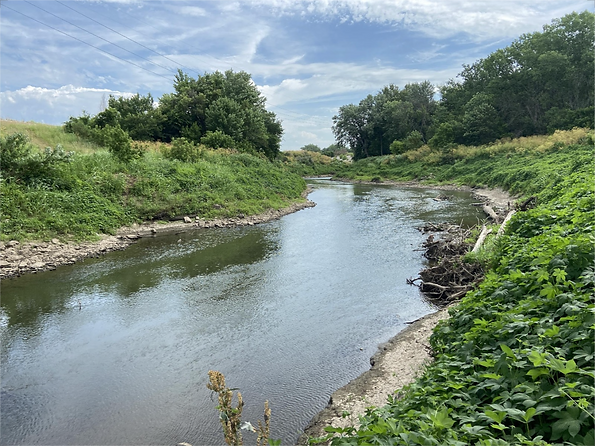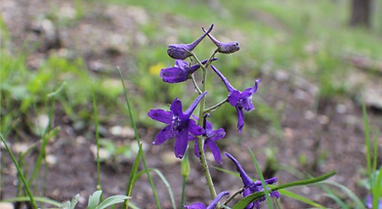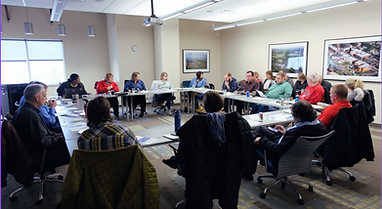
Core Pillars
This community-driven project is bringing new life to the Blue River—restoring nature, reducing flooding, and planting more trees in our neighborhoods, all while building local know-how to keep Kansas City’s waters cleaner and communities cooler.

Riparian Restoration
We're restoring natural systems along the Blue River Greenway to protect both neighborhoods and riparian ecosystems — because everyone deserves access to clean, safe, and healthy natural spaces and waterways.
This project is leading the region in using nature-based solutions to address climate change and improve water quality. By protecting and restoring woodlands, prairies, and native vegetation, the project helps mitigate climate change through carbon sequestration and increase climate resilience by reducing the impact of extreme weather, including stormwater flooding and erosion, on vulnerable local communities.
The restoration plan is being implemented in three phases, led by Heartland Conservation Alliance (HCA) and Bridging The Gap (BTG) on public land along the Blue River:
-
Phase 1: Baseline research, planning, and securing subcontractors
-
See HCA’s Request for Proposals in the lower watershed
-
See BTG’s Request for Proposals in upper watershed
-
- Phase 2: Removal of invasive species and native plant establishment
-
Phase 3: Establishment monitoring and maintenance
In short, restoration work focuses on enhancing the Blue River’s riparian corridors, bottomland hardwood forests, wetlands, and pollinator habitat by removing invasive species and strategically replanting native vegetation. These healthy ecosystems provide countless benefits to the plant, animal, and human communities that live around them. Aside from the stormwater, erosion, and carbon benefits described above, restoring the Blue River watershed to its original native state and improving our natural areas and parks also means cooler summers, less neighborhood crime, more accessible public land that we’re all free to use, and more opportunities to improve your mental and physical health by being out in nature. Additionally, the Blue River has been recognized for its biodiversity of imperiled pollinators, providing even more motivation to conserve, protect, and restore these areas. We're restoring the Blue River’s natural systems to protect neighborhoods and ecosystems because everyone deserves access to clean, safe, and healthy natural spaces.
Curious about the plants, animals, or restoration projects in your part of the Blue River watershed? We’d love to hear from you! Email Heartland Conservation Alliance at info@heartlandconservationalliance.org or Bridging the Gap at nature@bridgingthegap.org, and one of our biologists will be happy to assist.
You can also explore the Project’s Glossary of Terms to start learning more on your own!
Community Canopy

When you live in a city, it’s easy to forget that we’re all part of a watershed. A watershed is an area of land where all the rain and water drain to the same place—like a creek, river, or lake. The Blue River Watershed is one of Kansas City’s most important natural systems. It covers over 270 square miles and flows through city neighborhoods, suburbs, and natural green spaces before reaching the Missouri River.
In neighborhoods throughout the watershed, rainwater runs off streets, rooftops, and sidewalks — gray infrastructure. When there’s a strong storm, all that water can overwhelm our drains and cause local flooding. That might mean streets become unsafe to drive on, or someone’s basement floods every time it rains. As the city continues to grow and we get stronger, more frequent storms, this problem will likely get worse.
But there’s a simple, natural way to help… plant more trees!
Trees are a powerful type of green infrastructure. They catch rain in their leaves and branches, which slows down how fast it hits the ground. Their roots absorb water and help it soak into the soil, instead of rushing into our storm drains. Did you know one mature tree can take in thousands of gallons of water each year!? Trees also help stop soil erosion and clean polluted water by filtering out things like oil, fertilizer, road salt, and metals before it reaches our streams and rivers. By acting like natural water filters, trees help keep our creeks, rivers, and lakes cleaner and safer for people and wildlife.
Bridging The Gap’s Heartland Tree Alliance is working hand in hand with neighborhoods across the Blue River Watershed to plant and care for 1,700 trees as part of this project. With help from residents, we’re picking spots where trees are needed most— along our streets and in our parks. By hiding a forest in plain sight, we’re making neighborhoods cooler, helping to reduce flooding, and keeping our rivers cleaner.
Want more trees in your neighborhood? We’d love to hear from you! Email Bridging the Gap at trees@bridgingthegap.org and one of our community foresters will walk your neighborhood with you to plan where new trees could go.
You can also explore the Project’s Glossary of Terms to start learning more on your own!

Native Plant Solutions
The benefits achieved by planting more trees are enhanced by the addition of native plants into the Blue River Watershed. The regenerative practice of planting native encourages complex root systems that further filter water runoff and slow the flow of water, protecting the soil from erosion. Cleaner air and water are not the only benefits associated with this watershed restoration; reestablishment of the native habitat in this area will promote conservation of the many species that rely on it. Native plants directly support pollinators, butterflies, and birds and therefore are crucial for enhancing the Blue River’s native ecosystem.
Deep Roots KC is hosting training sessions for new gardeners to encourage more native garden development in our urban spaces. Training sessions cover the importance of native plants, native plant gardening and management practices, and include garden designs featuring keystone species and beginner friendly plants. Our “Cues for Care” management practices showcase the intention behind your native garden, which are often unconventional in urban and suburban yards. These training sessions, along with Deep Root’s many other native gardening events and resources, make native landscaping more accessible to residents along the Blue River Watershed.
Interested in growing your own native garden? Keep an eye on our Project Event Calendar to register for one of our training sessions. You can also schedule a consultation with a Nature Advisor—our Deep Roots specialists visit your home to assess your property and provide tailored recommendations to enhance its natural value.
Looking for more ways to get involved with our mission? Attend our Habitat Garden Tours to see native gardens across Kansas City, learn from local gardeners, and find inspiration.
You can also explore the Project’s Glossary of Terms to start learning more on your own!
Policy and Practice

Riparian Restoration Workshops
MARC is hosting a series of workshops in 2025 and 2026 to catalyze riparian restoration and stewardship in the Kansas City region. The workshop series’ focus on the active management of streamside landscapes aligns with multiple MetroGreen goals. Riparian restoration reduces flood risks and conserves air and water quality, habitat and biodiversity. Events targeting both public- and private-sector agencies will focus on policy, planning and skill-building. This series builds upon the momentum created by multiple partners restoring riparian lands in the Blue River watershed.
Practitioner/Land Manager Workshops
A four-part training and workshop series tailored for local government natural resource and parks staff, private landscape and restoration contractors, and environmental nonprofit professionals. Connect with regional experts and peers to learn best practices in riparian greenway restoration, exchange expertise, and prepare for successful multi-year project implementation. Participants will learn technical skill-building and process improvements — increasing the scale of restoration in the Kansas City region.
-
Renewing the Blue Restoration Workplan - August 22 2025
-
Regional riparian restoration: The why’s and how’s of riparian stewardship - August 27 2025
-
Restoration Success Stories – Multi-Year Management Strategies - Fall 2025
-
Riparian Agroforestry Best Practices - Spring 2026
-
The Restoration Project Process - Summer 2026
See our Project's Event Calendar for upcoming workshop dates and details.
Local Leaders Workshops
A two-part workshop series designed for local government decision-makers—including parks, public works, planning, and city management—and environmental nonprofit leaders. Learn from national and regional experts about the opportunities and practical benefits of riparian restoration, best practices for implementation, and strategies for long-term management.
-
Regional riparian restoration: The why’s and how’s of riparian stewardship - August 27, 2025
-
Restoration Success Stories: Long-Term Restoration Planning - Winter 2026
See our Project's Event Calendar for upcoming workshop dates and details.
Stormwater Best Management Practices
The Renewing the Blue project supports ongoing work to update guidance for stormwater design and management standards in the Kansas City region. This update is informed by modern stormwater practices, technology, data and modeling being utilized by stormwater professionals across the nation. Once adopted, the new MARC-APWA Section 5600 manual (see New APWA Manual Factsheet for an overview) will be a generational change in stormwater management for the region. The new draft guidance preserves natural areas and manages stormwater onsite, allowing for high-functioning, multi-benefit green stormwater infrastructure based on what works for the Kansas City region.
The current standards date back to 2003 and were last updated in 2012. See MARC’s Stormwater Best Management Practices webpage for project details and the draft stormwater management and design manual for engineers. This project is supported and guided by the APWA-Kansas City Executive Committee and 23 participating local governments.

Partnership
Together, we’re restoring the Blue River—for all of Kansas City.
This collaborative effort brings together public, private, and nonprofit partners to advance climate resilience, improve water quality, and restore natural systems across the Blue River corridor.
-
City of Kansas City, MO is the ARPA grant recipient and administering the grant funds to the four nonprofits listed below to support this large-scale regional initiative.
-
Heartland Conservation Alliance and KC WildLands (Bridging The Gap) are leading the restoration of riparian habitat, wetlands, and green infrastructure along the Blue River.
-
Heartland Tree Alliance (Bridging The Gap) is “hiding a forest in plain sight” by planting trees where they’re needed most — expanding the urban canopy to protect neighborhoods and reduce heat.
-
Deep Roots is establishing demonstration gardens, providing educational resources, and leading native gardening training sessions to showcase and encourage native landscaping in urban settings.
-
Mid-America Regional Council is leading technical training for restoration professionals and local decisionmakers, advancing supportive stormwater design & management policy and planning, and developing practical tools to drive implementation and long-term impact.
This is a unified effort to renew the Blue River and build a healthier, more resilient Kansas City—now and for future generations.
Community Engagement

The Blue River is Kansas City’s River— and we’re restoring it together.
We’re actively engaging the community in restoration through a wide range of hands-on programs and educational opportunities, including:
-
Raising awareness about the importance of riparian restoration and climate resilience through canvasing, community events, and signage
-
Leading hands-on learning with volunteers and community members to involve residents in on-the-ground restoration efforts, learn about how we all benefit from a healthy Blue River, and empower stewardship in their own backyards
-
Offering contractor trainings and educational seminars to build local green infrastructure and native landscaping capacity in private and government sectors
-
Organizing tree plantings in collaboration with community residents in their neighborhoods and local parks
-
Conducting demonstration tours that showcase native gardens as models of sustainable, resilient landscaping
-
Improving accessibility and recreational opportunities along the river to help more people connect with and enjoy the natural environment
Education and outreach grow community ownership—empowering those closest to the problem to lead the solution. Through these efforts, we’re fostering shared stewardship and equipping residents to care for and restore their local environment—because protecting the Blue River starts with empowering the people who live alongside it.
See our Project's Event Calendar for upcoming event dates and details.



